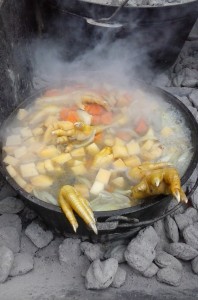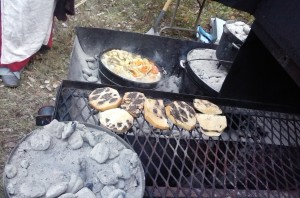It started as a lesson in waste-not-want-not.
Lady Anya (Jill Packard) had some chicken feet. She’d cleaned them and frozen them after the chicken harvest the year before, when she and her husband Lord Oleksander invited us to join in the annual harvest. Over a dozen of us slaughtered, plucked, and cleaned more than 50 chickens that day. I’d held those feet while I pulled feathers from many of those birds.
We decided that we should make some soup or stew with the feet, because they are reported to make wonderful broth. We figured that medieval people would have used as much of everything that they could, because it takes a lot of work to raise and harvest creatures to eat. Feet would be no exception.
We decided to look for a recipe that seemed reasonable, though we were totally comfortable making it up as we went along. That’s when we found a period recipe for a dish called, appealingly, “Garbage.”
Daniel Meyers had the recipe on his website which included three versions of the original recipes. We used this as inspiration. He had his own redaction but we were making our own recipe as we had slightly different ingredients and plans.
Source [Two Fifteenth-Century Cookery-Books, T. Austin (ed.)]: xvij – Garbage. Take fayre garbagys of chykonys, as the hed, the fete, the lyuerys, an the
Source [Two Fifteenth-Century Cookery-Books, T. Austin (ed.)]: Garbage. Take faire Garbage, chikenes hedes, ffete, lyvers, And gysers, and wassh hem clene; caste hem into a faire potte, And caste fressh broth of Beef, powder of Peper, Canell, Clowes, Maces, Parcely and Sauge myced small; then take brede, stepe hit in the same brothe, Drawe hit thorgh a streynour, cast thereto, And lete boyle ynowe; caste there-to pouder ginger, vergeous, salt, And a litull Safferon, And serve hit forthe.
Source [A Noble Boke off Cookry (Holkham MSS 674), R. Napier (ed.)]: To mak a garbaggysowrys; washe hem clene, an caste hem in a fayre potte, an caste ther-to freysshe brothe of Beef or ellys of moton, an let it boyle; an a-lye it wyth brede, an ley on Pepir an Safroun, Maces, Clowys, an a lytil verious an salt, an serue forth in the maner as a Sewe.e tak the heed the garbage the leuer the gessern the wings and the feet and wesche them and clene them and put them in a pot and cast ther to brothe of beef poudere of pepper clowes maces parsly saige mynced then step bred in the sam brothe and cast it to pouder of guingere venygar saffron and salt and serue it.

We also knew that the Jamacians use them for soup even now. And that they’re considered good eating in many Asian cultures.
It’s recognized that they bring extra good things to a soup, health-wise, and one cook thought that they would even help make joints feel better – especially with a little vinegar added to help bring calcium from the bones.
Medieval veggies are often made into thick stews called pottage. Broad beans are common, so we used lima beans. Carrots are less common (and would have been purplish!) and turnip seemed to usually have more going on with it (cheese!) and onions were…largely unmentioned in many pottages. But we wanted to do this our way and we chose to add veggies. We decided not to add the bread, in the end.
And because there was a pot-luck, we figured, what the heck, let’s do this thing and see if people will eat it! (Which was another reason to not just make broth.)
At the Endewearde Hunt, which is in October in Maine, soup is a good thing. It’s also good for a crowd and easy to cook outdoors.
Recipe
- 12 chicken feet, well washed
- 2+ lb onions
- 1-2lb carrots
- 2 medium rutabagas
- 2 bags frozen lima beans
- 5 marrow bones
- water sufficient to cover things
- mace, clove, salt, pepper, saffron
- cider vinegar
- gluten free bread to thicken (we decided not to bother)
In a cast iron Dutch oven, we warmed the bones in a little water to get the flavor moving in them.
In a larger pot, we added cut onions, carrots, and turnips. We made velociraptor noises and played with the chicken feet. We artfully arranged them in the pot. We took photos. When we had finally had enough of that, we added the spices. We splashed in some vinegar then we poured the marrow bone drippings from the second Dutch oven and added one of the bones to the mix.
We put it on hot coals and put coals on the top of the lid. Then we let it do its thing. It cooked on very hot coals for a couple of hours. When finally served, it had lost some vibrancy and much liquid, but was a really pottage-y pot of melt-in-mouth soft vegetables.
(We also made a second soup – marrow bone and onion with the same spices, only not much of them – and it was delicious.)
Pot-Luck Public Reception
We served it in the cooking pot but pulled out most of the feet, so people could access the pottage unhindered. We put the cooked feet on the pot lid beside the dish and to our serious surprise, some brave people took them to eat (we heard there were challenges). Those who ate the soup part said it was tasty (I thought it too vinegary and not spicy or salty enough) and those who ate the feet said they were weird and didn’t have much meat (which is not a surprise.)
Overall though, we were delightedly surprised that people were so comfortable with eating something so “weird” and unusual on even an SCA table. We’re thinking of how we can do it again with a better recipe.
And in spite of my dislike of liver, we may even try to make Garbage on the next go!
Web resources
http://medievalcookery.com/recipes/garbage.html
http://www.lovefood.com/guide/recipes/27272/spicy-chicken-feet-recipe and https://recipes.sparkpeople.com/recipe-detail.asp?recipe=1859445
http://blog.fooducate.com/2013/02/10/heres-why-you-should-add-chicken-feet-to-your-soup/

